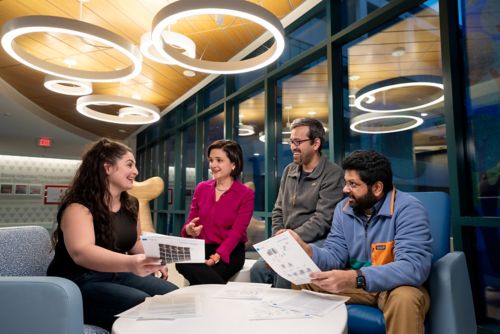St. Jude Family of Websites
Explore our cutting edge research, world-class patient care, career opportunities and more.
St. Jude Children's Research Hospital Home

- Fundraising
St. Jude Family of Websites
Explore our cutting edge research, world-class patient care, career opportunities and more.
St. Jude Children's Research Hospital Home

- Fundraising
Scientists combine novel CAR design and AI to improve CAR T–cell immunotherapy
Chimeric antigen receptor (CAR) T–cell therapy redirects a patient’s own immune cells to target a cancer-specific protein. Optimizing CAR T–cell therapy for different pediatric cancers requires improved understanding of T–cell biology and immune processes. One challenge in the field has been identifying tumor-specific targets that are both uniformly expressed and not essential in healthy tissues. St. Jude scientists are addressing this issue by designing and developing CARs with more sophisticated targeting ability. The work provides foundational understanding that may guide future CAR T–cell design across cancer types.
The study, published in Cell Reports Medicine, showed how a computational approach incorporating AlphaFold2, an AI-powered protein folding prediction tool, could shed light on how structure impacts CAR T–cell function in acute myeloid leukemia (AML). Combining this improved CAR design with computational prediction could potentially expand treatment options for AML and other malignancies traditionally resistant to current therapies.

(L to R) First author Jaquelyn Zoine, PhD; senior corresponding author Paulina Velasquez, MD, St. Jude Department of Bone Marrow Transplantation & Cellular Therapy; co-author M. Madan Babu, PhD, FRS, Department of Structural Biology; and second author Kalyan Immadisetty, Department of Bone Marrow Transplantation & Cellular Therapy used AI-powered protein prediction and a dual-target CAR design to enhance CAR T–cell therapy for leukemia in a study published in Cell Reports Medicine.
“One of the most exciting aspects of the approach is that although we focused on leukemia, it can be widely extrapolated to other tumors such as solid and brain tumors,” said senior corresponding author Paulina Velasquez, MD, Department of Bone Marrow Transplantation and Cellular Therapy.
The researchers created a unique single-molecule CAR, which includes the region of an antibody that binds a specific target (its antigen) and one short peptide that binds a separate target. These two binding domains are connected by a linker, enabling the CAR to target two different cancer-related proteins.
This approach overcomes inefficiencies in CAR T–cell therapy caused by the inability to target large antibody fragments. “Our approach added a small peptide, enabling our CAR to engage either target to prevent immune escape,” said first author Jaquelyn Zoine, PhD, Department of Bone Marrow Transplantation and Cellular Therapy.
The dual-targeted CARs outperformed single-targeted CARs in both in vitro and in vivo experiments, demonstrating their promise. However, the researchers struggled to determine the optimal linkers to use between the binding domains. The physical structure of the targeted molecule and its linker can interfere with target binding on the cancer cell, so identifying the most effective linker could further improve the therapy.
Using computational structure prediction and comparing structures with experimental results, the researchers found that shorter, more flexible linkers improve binding and efficacy. “A linker of sufficient flexibility and shorter length can scan a larger volume and is more likely to find the target proteins on the cancer cell,” said co-author M. Madan Babu, PhD, FRS, Chief Data Scientist and Senior Vice President for Data Science.
As one of the few groups in the world employing AI-based structure prediction tools for CAR T–cell design, the researchers hope their method will encourage others to improve CAR designs and enhance treatments for pediatric cancers.